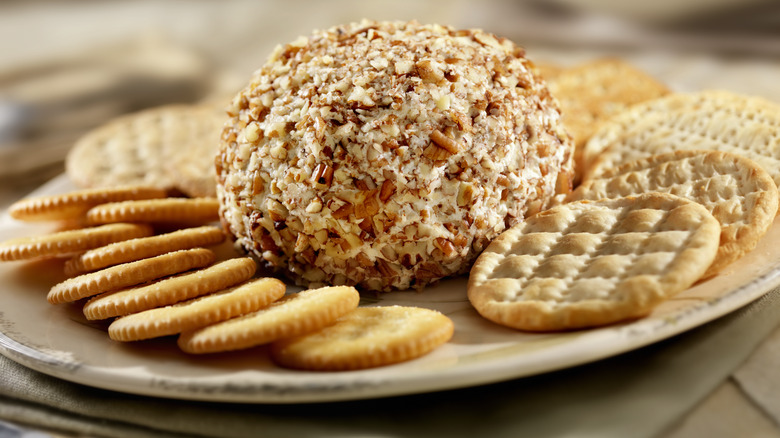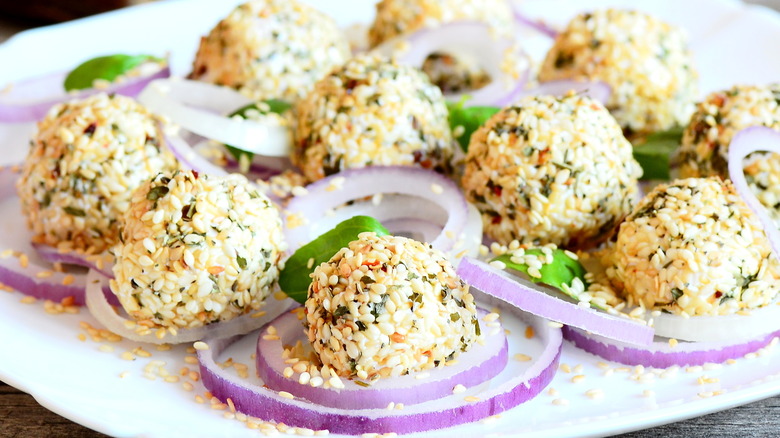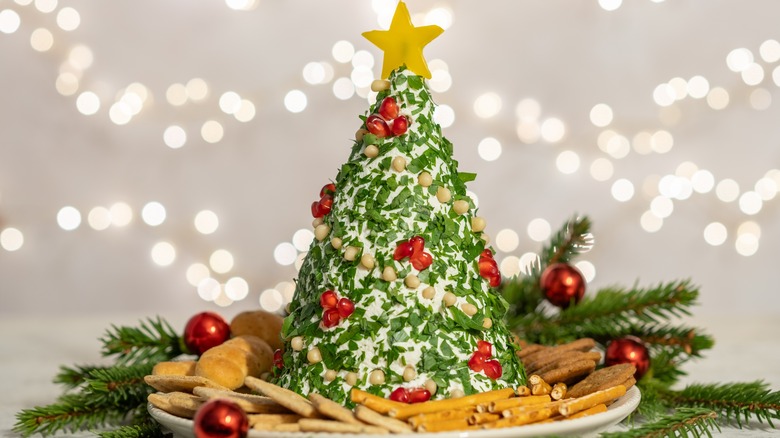It's Time For A Cheese Ball Renaissance
The cheese ball doesn't date back quite as far as the actual Renaissance, a period that had pretty much wrapped up by the turn of the 17th century, but this retro appetizer has been around for a good long time. While some sources claim that the very first cheese ball was presented to Thomas Jefferson in 1801, the impressive (if impractical) gift received by our third president was just an enormous, circular block of cheese. It was more of a cheese wheel than a cheese ball. The kind of cheese ball we're talking about here consists of a sphere of flavored cream cheese rolled in a garnish of some sort. The first recipe we're aware of was published in a 1944 cookbook called "Food of My Friends." This recipe collection was compiled by food writer Virginia Safford, but the cheese ball itself was attributed to one Mrs. Selmber E. Ellertson.
Cheese balls, like many other mid-century fads, came to be seen as a bit stodgy and outdated by the turn of the millennium, but we'd like to see them stage a revival as our century hits the quarter mark. They're a party appetizer with prep work easy enough to outsource to a preschooler and sufficient customizability to allow you to add as many quick-pickled figs, caramelized shallots, or other au courant ingredients as your trendy little heart desires.
Cheese balls have come a long way, baby
The original cheese ball recipe from "Food of My Friends" was very fancy for the '40s — the cream cheese was mixed with blue cheese and flavored with Worcestershire sauce and chopped chives, then formed into a ring and topped with caviar (Wait, wasn't there a war on? So much for wartime austerity). It still counted as a cheese ball, though, since it offered the option of rolling the cheese into a sphere. In a follow-up cookbook compiled by Virginia Safford, 1969's "Friends and Their Food", a far simpler recipe for Cheese in the Round is attributed to Mr. and Mrs. Charles C. Arnao Jr. It's made with canned mushrooms, cream cheese, Worcestershire sauce, and chopped parsley.
Even by 1960s standards, the Arnaos' cheese ball may have been considered a bit bland, since cheese ball recipes from just a few years later contained all manner of additional flavorings such as grated cheddar, olives, and pimentos. Many 1970s cheese balls also used chopped nuts as a coating in place of parsley, thus achieving some textural contrast. 21st-century cheese balls are doing their best to shake off the last vestiges of their suburban cocktail party roots by glamming themselves up with ingredients such as dried cranberries, goat cheese, prosciutto, and upscale sweeteners like hot honey and fig jam.
Sometimes they're not even round
While "ball" is part of the name, cheese balls aren't always spherical (Nor are balls, for that matter, as football fans can attest)/ The recipe that's credited as being the first-ever cheese ball was actually meant to be ring-shaped, after all, with the ball version seeming almost an afterthought. Another recipe from "Friends and Their Food," this one attributed to Dorothy (aka Mrs. Harry E.) Gerrish, is for log-shaped cheese rolls, and you can also find recipes for cheese balls that are made to look like pine cones or pineapples.
Around the holidays, non-spherical cheese balls really come into their own. Christmas cheese ball recipes include snowman and tree shapes, while Halloween ones include pumpkins, witch hats, and skulls. The one day that cheese balls are de rigueur, however, is April 17, as that date has been designated as National Cheese Ball Day. To mark the occasion, you can go round, square, or free-form, as long as you celebrate with some sort of compressed cheese concoction. Being lactose-intolerant or vegan will not excuse you from this obligation, since plant-based cheese spreads and cream cheese substitutes mean that non-dairy "cheese" balls are also an option for celebrating this cheesiest of all holidays.


